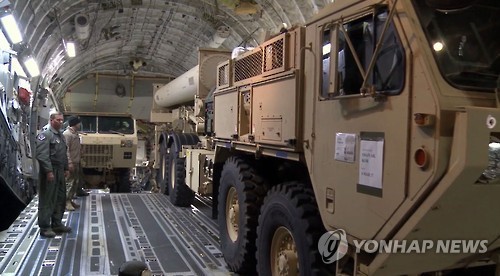US missile systems form shield against N. Korean threats
By KH디지털2Published : March 7, 2017 - 18:00
A US missile defense system being deployed here is expected to enhance the capabilities of Seoul and Washington to counter Pyongyang's escalating missile threats, though it may not be a panacea, officials and experts here said Tuesday.
The Terminal High Altitude Area Defense system will form an effective multiple-interception system at the terminal phase when it goes together with the PAC-3 system, they said.
THAAD is designed to intercept short and mid-range missiles which have a range of up to 3,000 kilometers at altitudes of 40-150 kilometers.
The military could try to strike an incoming missile with the THAAD system. If THAAD fails to intercept it, the Patriot missile defense system could step in to down the missile at altitudes of 15-40 kilometers, an official at the defense ministry explained.
He pointed out that the THAAD system may have difficulties in defense capabilities if multiple missiles are fired at the same time from the North. The system can be loaded with 48 missiles and it takes about 30 minutes before another 48 missiles are fully reloaded.
"THAAD won't be able to intercept a massive amount of missiles launched by North Korea at one time as the communist state did on Monday," he said.

On Monday, Pyongyang test-fired four ballistic missiles, believed by Seoul's military to be "improved versions" of Scud missiles, into the East Sea in an apparent protest against the ongoing military drills between Seoul and Washington.
A day after the missile firing, the process began to install a THAAD battery in South Korea within a couple of months.
It clearly shows the allies now accept the North's continued provocations, including the assassination of Kim Jong-nam, the estranged half brother of leader Kim Jong-un, as a "real and imminent threat" to peace and stability on the Korean Peninsula and the region, the official said.
The first elements of the THAAD system, including two launchers, arrived at Osan Air Base in Pyeongtaek, 70 kilometers south of Seoul, Monday, the ministry said.
A C-17 Globemaster III transport aircraft has delivered the first equipment which will be transferred from the US air base to the southeastern rural county of Seongju, about 300 kilometers south of Seoul, the site for the battery, it said.
A THAAD battery consists of six truck-mounted launchers, 48 interceptors (eight per launcher), a fire control and communications unit, and an AN/TPY-2 radar.
"Four more launching pads, the control and communications unit and the radar system have yet to be brought in," another official said.
The system's powerful radar system is capable of detecting an incoming missile 600-800 kilometers away. A THAAD battery could offer a shield against missiles for up to two-thirds of South Korea, he explained.
For the defense of the remaining part of the country, the upgraded version of the PAC-3 system will be used, military officials said. They didn't rule out the deployment of additional THAAD batteries in South Korea for better defense against North Korean missiles.
Seoul and Washington have said the system is purely defensive and poses no threat to other countries in the region. But China and Russia have opposed it, arguing the system's powerful radars could pose a security threat to them. (Yonhap)



















